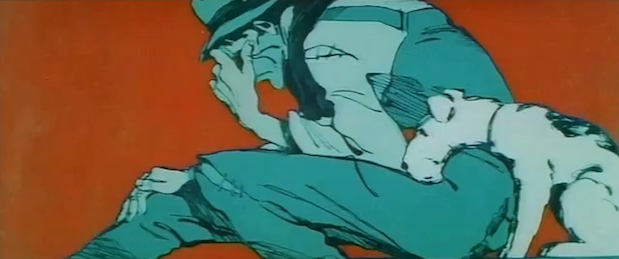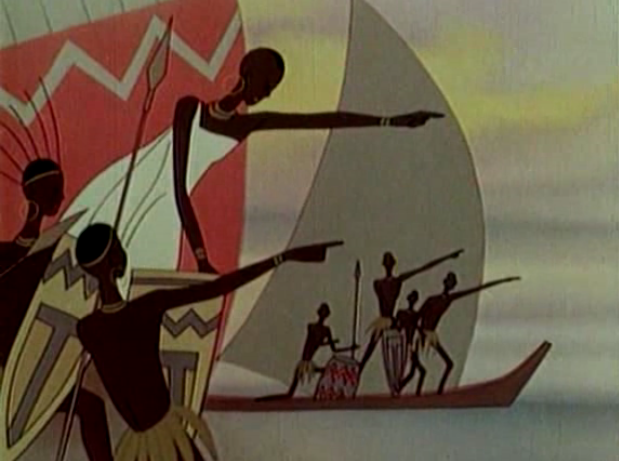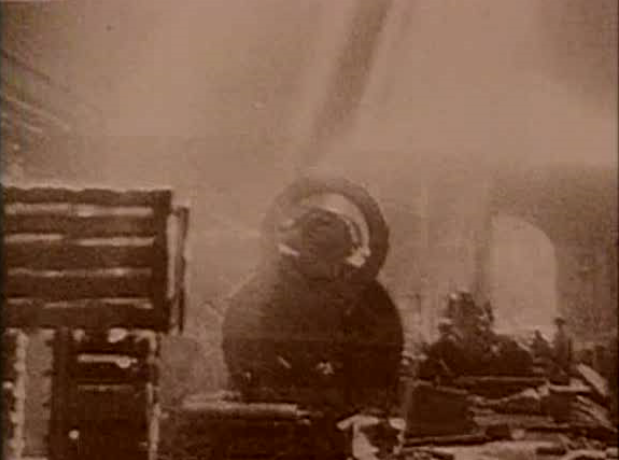Akcionery (Shareholders)
Roman Davydov, 1963
Through this yarn of a man - by appearances the embodiment of American folk ideals - who purchases a share in a major corporation with the idea it will fix his life's financial problems only to watch the corporation's stock plummet, an internal conflict between capitalist and communist mentalities is made uniquely apparent. In capitalist society one grinds themselves in workplaces to earn the money required to survive coinciding daily trials while being told this cruel cycle is a privilege. This raises a question of capitalist systems possibly being impeded by the same basic source of dysfunction as communism - human nature. Also of note in The Shareholder is the introduction of robots replacing humans in the workplace, suggesting the practice as detrimental to the capitalist working class but possibly a boon to communism in lines with Lenin's "plus electrification" theory. Watch Shareholders.
Gordyi korablik (Proud Little Ship)
Vitold Bordzilovsky, 1966
A small, red model of the Soviet battleship Aurora (which allegedly fired the first shot of the October Revolution) is set to sea by children where it is carried from shore to shore on the currents of communism, inspiring other lands and infuriating capitalist pursuers. As in We Can Do It, Vasilyok, and other titles, it is purported that simply being a proud communist makes one mighty and beloved. Here our crimson symbol is entirely passive, but becomes indomitably influential even against an entire fleet of tap-dancing, shark-inflating, robot-owning, Weeble-looking (and likely Uncle Sam-wanted) enemies to which the inanimate protagonist is blissfully oblivious. When it reaches new lands it is cherished but not coveted and always set back to be shared with others. Often visually appealing (as are many of these shorts) and honestly amusing, Proud Little Ship is one of this series' more successful executions of its simple idea this side of the more thematically complex entries. It comes from the director of The Millionaire with animation from Shooting Range director Vladimir Tarasov, who describes the experience as indispensable. Watch Proud Little Ship.
Mezhplanetnaya revolyutsiya (Interplanetary Revolution)
Nikolai Khodataev, 1924
Much like the same year's Aelita from director Yakov Protazanov, Interplanetary Revolution depicts 1920s Mars expeditions as revelatory of extraterrestrial intelligent life in capitalist hierarchy. This is used as careful allegory for planetarily local parties, Nazis in particular. Unlike Aelita, in this case the alien lifeforms are grotesque soul-suckers whose misdeeds reflect in their appearance (as illustrated through the use of mirroring shapes to create both money-glutted cheeks and subsequently unsightly behinds). Despite haunting by Red ghosts - an implication that communism is a universally permeating force - the creatures are unrepentant in the cruelty of their greed. Parallels to Protazanov's film are no mere coincidence; scrapped backdrops and sketches for Aelita's animated sequences designed by artist Zenon Komisarenko's team (which included Nikolai Khodataev) were implemented here in parody of the feature. Revolution's inventive cutout animation packs an eyeful into the seven and a half-minute runtime. Watch Interplanetary Revolution.
Kitaj v ogne (China in Flames)
Nikolai Khodataev, 1924
The USSR's first full length animated film (of which only a recovered 31 minutes is considered here) is also the first example of propaganda altruistically proposing support for neighboring countries, even if it seems to have a marked financial motivation regarding trade with China. Khodataev calmly covers similar symbolism to that in his Interplanetary Revolution with the same visual style. The piece straight-forwardly educates as to China's social condition before delving into the story, which features the usual corpulent capitalists this time setting their sites on the large Eastern country. A final command to Soviets declares: "Support with all your strength the struggle of the Chinese workers. The struggle of China is your struggle." Watch China in Flames.
Proroki i uroki (Prophets & Lessons)
Vyacheslav Kotyonochkin, 1967
An energetic and amoebic blend of traditional cel animation (based on Boris Yefimov drawings) and live action propaganda painting capitalists as flimsy hucksters who may attempt to conquer the Motherland but will always fall beneath the immutable communist hammer. Watch Prophets & Lessons.
Budem Zorki (We'll Keep Our Eyes Peeled)
The Nikolai Khodataev Group, 1927
A rallying song accompanied by images both animated and live action to encourage Soviets to purchase "obligazia" - government bonds rarely paid back - in aid against capitalists who don't understand the glory of communism. Rise up, workers, and drive out the British trade embargo with donations! Incidentally, the embargo in question is apparently nonexistent in any Western history book. Though minutely more complex, We'll Keep Our Eyes Peeled is not too far off from the WWII anti-Hitler posters portraying the dictator as either an imp or a pig as he tramples a Eurasian map. In this prior case it's Britain's early 1920s foreign secretary George Nathaniel Curzon meddling with a map of trade routes. Watch We'll Keep Our Eyes Peeled.
Much like the same year's Aelita from director Yakov Protazanov, Interplanetary Revolution depicts 1920s Mars expeditions as revelatory of extraterrestrial intelligent life in capitalist hierarchy. This is used as careful allegory for planetarily local parties, Nazis in particular. Unlike Aelita, in this case the alien lifeforms are grotesque soul-suckers whose misdeeds reflect in their appearance (as illustrated through the use of mirroring shapes to create both money-glutted cheeks and subsequently unsightly behinds). Despite haunting by Red ghosts - an implication that communism is a universally permeating force - the creatures are unrepentant in the cruelty of their greed. Parallels to Protazanov's film are no mere coincidence; scrapped backdrops and sketches for Aelita's animated sequences designed by artist Zenon Komisarenko's team (which included Nikolai Khodataev) were implemented here in parody of the feature. Revolution's inventive cutout animation packs an eyeful into the seven and a half-minute runtime. Watch Interplanetary Revolution.
Kitaj v ogne (China in Flames)
Nikolai Khodataev, 1924
The USSR's first full length animated film (of which only a recovered 31 minutes is considered here) is also the first example of propaganda altruistically proposing support for neighboring countries, even if it seems to have a marked financial motivation regarding trade with China. Khodataev calmly covers similar symbolism to that in his Interplanetary Revolution with the same visual style. The piece straight-forwardly educates as to China's social condition before delving into the story, which features the usual corpulent capitalists this time setting their sites on the large Eastern country. A final command to Soviets declares: "Support with all your strength the struggle of the Chinese workers. The struggle of China is your struggle." Watch China in Flames.
Proroki i uroki (Prophets & Lessons)
Vyacheslav Kotyonochkin, 1967
An energetic and amoebic blend of traditional cel animation (based on Boris Yefimov drawings) and live action propaganda painting capitalists as flimsy hucksters who may attempt to conquer the Motherland but will always fall beneath the immutable communist hammer. Watch Prophets & Lessons.
Budem Zorki (We'll Keep Our Eyes Peeled)
The Nikolai Khodataev Group, 1927
A rallying song accompanied by images both animated and live action to encourage Soviets to purchase "obligazia" - government bonds rarely paid back - in aid against capitalists who don't understand the glory of communism. Rise up, workers, and drive out the British trade embargo with donations! Incidentally, the embargo in question is apparently nonexistent in any Western history book. Though minutely more complex, We'll Keep Our Eyes Peeled is not too far off from the WWII anti-Hitler posters portraying the dictator as either an imp or a pig as he tramples a Eurasian map. In this prior case it's Britain's early 1920s foreign secretary George Nathaniel Curzon meddling with a map of trade routes. Watch We'll Keep Our Eyes Peeled.


















































